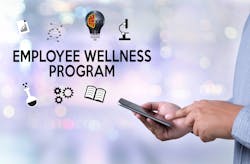Pandemic Increases Significance of Employee Wellness Programs
As the National Academy of Medicine has pointed out, even before COVID-19, many clinicians experienced stress and burnout, as well as depression, substance abuse, and suicidality. Providing care during the pandemic has sharply exacerbated these trends. But health systems that have invested long term in wellness programs have been able to ramp up their efforts to meet the increasing need.
South Carolina-based Tidelands Health has been working on a systemic and data-driven approach to employee wellness and safety for over a decade, and found its long-term focus on employee wellness paid off when the pandemic struck.
“Everything that we do is based upon an established policy program that we call our culture of wellness and safety,” explained Jan Harper, executive vice president and chief human resources officer for Tidelands Health, “and within that program are 21 different programs. We did see some upswing and some variation in some of those components during the pandemic, but nothing that would cause us to do anything different than what we already had in place. We have been doing some extraordinary things over the past decade.”
Tidelands Health, a four-hospital system serving the Carolinas, uses a platform from WellRight, a well-being technology company, to track their progress in physical, mental, emotion and financial health.
“We have dashboards that we've continued to improve upon,” Harper said. “We are true believers in metrics, and 15 years ago, we began a long, long way below what we wanted our dashboard to look like before we really began in earnest pulling these programs together and having them work in a symbiotic relationship.”
Tidelands has been working with WellRight for three years. “The program continues to evolve and get better each year,” said Renee Shore, M.P.H., director, EAP and wellness, for Tidelands Health. “What helps us to overcome the engagement struggles that some health systems face with their wellness programs is that we have a dedicated wellness team that's responsible for biometric screenings, health coaching, and disease management. We get to know all of our employees and their families on that very personal, individualized level, so that really helps with engagement.”
Shore said working with the WellRight platform “has really opened the door for us to create a very immersive experience where it's easy for the end user. They actually like using the platform,” which has not always been her experience with other programs in the past. “It gives us the flexibility to meet our participants where they are.”
Harper noted that Tidelands has hard-wired its wellness program with its health plan. “By doing so, we reward you for accomplishing certain base activities as well as bonus activities,” he explained. “If you don't complete five or six base activities. including disease management if you are identified as having one of five or six different diseases, then you don't qualify for up to $1,000 that would otherwise offset your out-of-pocket expenses.”
“We are able to see a direct correlation between high involvement or engagement in the wellness program and the offsets that appear in the bottom lines as far as our benefits,” Shore added.
One of the required base activities is a financial wellness program that involves at least once on a biannual basis connecting with a qualified, experienced financial planner.
“A lot of the employees who come on board are not necessarily familiar with our culture of wellness and safety, and they're surprised by some of the programs that they're responsible for participating in,” Harper noted. When they first launched the financial wellness program, they received pushback from some employees, Harper said. “But now we’ve got close to a 95 percent acceptance rate and a 95 percent approval rating. They come on board asking why we have the right to tell them what to do, but afterwards, they understand and appreciate the program that we brought to the table.”
Tidelands offers biometric screenings, in which member of the wellness team reach out to staff members to get quick biometric readings — height, weight, BMI — and talk about why those external biometric numbers are important, and what they might say about overall health. “We have conversations about hypertension and healthy lifestyles, and do coaching and individualized goal setting,” Shore said. “We also do annual blood screening. We take a look at glucose and lipid panels, and we do tobacco screenings.”
Shore said she and Harper like being able to do deep dives with the data to pull reports and slice and dice it in different ways to help identify opportunities for progress. “That helps tie everything right back into our own program’s ROI, and cost avoidance and cost savings.”
For instance, she said, one thing that jumped out at her from looking at the data recently is that they have an opportunity to better engage new employees. “We have this robust workforce coming on board and they're learning their new roles and responsibilities within the organization, so maybe wellness isn't immediately at the top of their to-do list,” Shore said. “We can do a better job of reaching out to those new employees and letting them know about the opportunities that are available there and getting that population to engage.”
Health systems vary in the sophistication and variety of their wellness offerings, notes Neepa Patel, CEO of WellRight.
Tidelands is on one end of the spectrum in terms of the depth of their wellness program, in terms of how well thought out and multi-dimensional it is, Patel said. “With the pandemic, the burnout issue is very real, so we have seen more uptake in those aspects of our program related to emotional and social well-being,” she said. “Part of what we're able to do is supply additional content. When COVID hit, the platform was flexible enough that we could add content that can help employers and employees think about the pandemic in some context, but also provide some tools around mental well-being and checkpoints for employers to think about how to engage their nurses and physicians during a heavier burnout period.”


